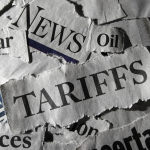When Donald Trump returns to the White House on January 20, one of the first items on his agenda may be to impose tariffs.
During his presidential campaign, Trump promised to put tariffs of 60% on all imports from China and 10% on all imports from the rest of the world.
So what are tariffs and how do they work?
A tariff is a government levy, which gets added to the cost of an import, and which is paid by the buyer. For example, if XYZ Incorporated imports a $100 pair of shoes that attracts a 10% tariff, XYZ Incorporated pays $100 to the shoe exporter and $10 to the government.
Governments tend to impose tariffs for some or all of these reasons:
- To protect local manufacturers. Now that foreign shoes have become $10 more expensive, XYZ Incorporated and other buyers might decide to buy local shoes instead. As a result, local shoe manufacturers may become more profitable and hire more local workers.
- To raise revenue. The government will collect levies from any business that continues to import foreign shoes.
- As an extension of foreign policy. The government may decide to apply tariffs selectively – to impose them on shoe exporters located in less-favoured nations but not on those based in friendly countries.
But like all economic policies, tariffs also have downsides, because they:
- Make local businesses less efficient. Now that local shoe manufacturers don’t have to compete as hard to win customers, they have less incentive to minimise their shoe prices and improve their manufacturing processes.
- Force local buyers to pay higher prices. If XYZ Incorporated continues buying foreign shoes, it will have to pay 10% more – and will probably pass on some or all of these higher costs to its customers.
- Encourage other countries to retaliate. If Country A imposes a 10% tariff on Country B, Country B will probably do the same to Country A. As a result, local shoe manufacturers will no longer have a competitive advantage – and everyone in both countries will have to pay more for shoes.
How Trump’s tariffs may directly affect Australia
If the Trump administration imposes a 10% tariff on all Australian goods, this will have a major impact on our economy, according to Susan Stone, the chair of economics at the University of South Australia.
Dr Stone, writing in The Conversation, said that while America accounts for only 5% of our exports, it’s a major customer of our advanced manufacturing sector.
“Within Australia’s exports, more than 40% of high-tech engines, 50% of aircraft and space parts and almost 60% of machine tools are sent to the US,” she said.
“If Australia wants to become a bigger player in the advanced goods and services market, it needs to be an effective global competitor. Any increase in barriers to the US market will hamper this goal.”
How Trump’s tariffs may indirectly affect Australia
Furthermore, Dr Stone noted that if the Trump administration imposes tariffs on the rest of the world, other countries “will almost certainly follow suit” – and may also seize the opportunity to impose additional tariffs on other countries.
“The global impacts of the tariffs, such as rising shipping costs, increased volatility in the US dollar, and a general increase in uncertainty and risk, will almost certainly flow on to Australia,” she said.
“Trade is a major part of the Australian economy, accounting for as much as 45% of GDP. That means when the costs of doing business internationally grow, it can seriously impact Australian businesses and consumers.
“When Trump raised tariffs on China in 2018, ocean container shipping market rates spiked by more than 70%. Global shipping is already under pressure due to ongoing conflicts in Europe and the Middle East. For a country as far away from major markets as Australia, higher shipping costs put our goods at a significant price disadvantage.
“Australia will also need to watch the impact of Trump’s policies on China, still our largest two-way trading partner. Large tariffs on China could slow its growth, in turn slowing its imports of Australian exports such as iron ore.”
The market impact is uncertain
So what impact will Trump’s tariffs and a potential trade war have on markets?
No one knows.
The global economy is a vast, complicated organism that is affected by many and diverse factors – with America’s trade policies being just one of them.
It’s possible that markets may perform poorly under Trump. But the opposite may also occur: during Trump’s first term, from January 2017 to January 2021, markets rose – the All Ordinaries by 22.1% and the S&P 500 by 66.0% (both excluding dividends).
History teaches us that global crises and market volatility are the rule, not the exception – and yet, over the long-term, markets have enjoyed incredible growth. That’s why, when it comes to investing, it’s generally wise to block out the short-term noise and play the long game.
















